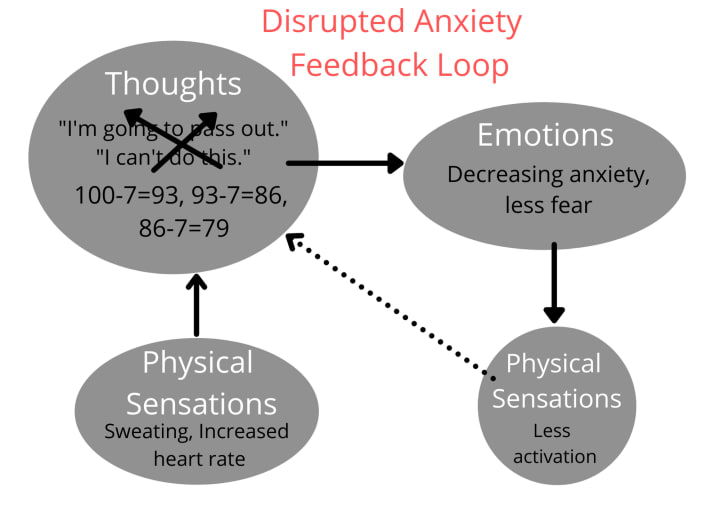A Simple Technique to Immediately Interrupt Anxiety
A psychologist-tested strategy

Anxiety is like a stomach bug — it comes on strong at the most inopportune times.
One such time for me occurred during my pre-doctoral internship. I was on a three-month rotation with the neuropsychology service — a training requirement for graduation, but not my chosen subspeciality. I was assigned to observe a procedure in which a patient received direct electrical stimulation to his brain.
The patient was fully conscious and talking while different areas of their exposed brain were stimulated with electrodes. Exposed brain! That bears repeating because it is a crucial part of the story.
My task was simply to observe the neuropsychologist as he completed his part of the assessment. I was facing the patient and had no visual of the brain, but I knew what was going on behind the white sheet.
Since I had no specific role in this procedure, I had plenty of time to think about what was going on in the room, and my thoughts kept coming back to the brain. What color was it? Did it feel squishy? Was the scalp still attached to the skull? Was that peculiar smell the human brain burning?
As these thoughts were running through my head, I could feel my anxiety increasing. I started to feel lightheaded and a little nauseous.
Then, a horrible thing happened — the neurologist asked if I wanted to see how he was marking the brain. I absolutely did not! But, I was an intern and my sole purpose in that room was to learn, so I didn’t feel that a “no, thank you” would be well received.
I slowly walked towards the patient’s head and the next thing I recall, I was lying on a cot in the nurses’ station.
Thankfully, I fainted away from the sterile field, out of reach of the brain, so I had no opportunity to accidentally pull on any attached electrodes as I fell.
After the Fall
As I sat there catastrophizing about how my career was over just as it was getting started, a nurse with a sympathetic smile reassured me that I was not the first intern to pass out on her floor. I appreciated her kindness but knew this could not happen again if I hoped to pass the rotation.
I only had a few days before the next scheduled procedure, so I needed a plan. I had years of training in cognitive behavioral therapy (CBT) and knew my alarming thoughts were triggering the anxiety. I needed to keep my mind busy during the procedure. Since I like numbers, I decided to try doing simple math problems in my head if I felt my anxiety surfacing.
To my great relief, the math problems worked and kept my anxiety controlled. With the help of cognitive distraction, I did not faint again on that rotation.
Over the years, I have continued to use math problems to fight escalating anxiety with impressive results. I used it today while riding in the car with my 15-year-old who just got his learner’s permit! This strategy is also helpful when my sleep is disrupted by troubling thoughts.
It is a quick, portable technique that will immediately take the edge off anxiety.
The Nature of Anxiety
To understand why cognitive distraction works, it is necessary to first know how anxiety escalates.
Anxiety gains power through a feedback loop — output from one system provides input for the next system.
There are many reasons why someone might feel anxious. For some, social situations are difficult. For others, it is a particular item or experience that triggers anxious symptoms like spiders, snakes, riding in elevators, or flying in a plane. Anxiety can result from trauma or be a more general sense of unease with no easily identifiable trigger.
Regardless of the cause, anxiety escalates similarly across all these scenarios. You experience a situation, interpret it as a threat, and your body becomes physically activated. You then perceive your body’s reaction as proof that there is danger which leads to even more physical activation and unhelpful thoughts.

The cycle continues until you interrupt it, or remove yourself from the situation.
During the medical procedure many years ago, I started thinking too much about the exposed brain which triggered anxiety and made me feel lightheaded and nauseous. When I noticed my physical discomfort, I began worrying that I was going to be sick which led to even more anxiety and increased physical symptoms.
If I could have sprinted out of that room, I would have in a heartbeat. Instead, I sat in the chair thinking about how sick I felt. When I stood up and started to walk, I passed out.
A more universal example is when you are preparing to give a speech in front of a group. You are understandably nervous and begin to notice sweating, increased heart rate and lightheadedness. You tell yourself, “I don’t want to do this. This is too hard.” These unhelpful thoughts create more anxiety which leads to increased sweating and panic-like feelings. You then think, “I’ve got to get out of here or I’m going to be sick. I can’t handle this.” You leave the room.
When you leave the room, the threat of the speech is no longer imminent and you feel a little better. But, your relief does not last. You still have to give the speech, otherwise, there will be negative consequences to your job, grade, or reputation. This avoidant behavior is not beneficial in the long run.
Instead of fleeing the situation, a better option is to interrupt the feedback loop and stop the anxiety from escalating. One helpful method for instantly disrupting the escalation is cognitive distraction — a CBT technique that temporarily suppresses unhelpful thoughts.
Stop the Spinning
If a bicycle wheel is spinning and you put a stick between the spokes, it immediately stops moving. Cognitive distraction techniques are similar to the stick — it stops your head from spinning.

At the first signs of physical activation (increased heart rate, sweating, chills, upset stomach, shaking, lightheadedness, etc.), immediately engage in a cognitive task. When you are actively thinking about something else, you are not focusing on anxiety-provoking thoughts. The task needs to be challenging enough to require your full attention.
I do subtraction problems in my head by picking a random number and subtracting by seven. When I reach zero (or close to it), I pick a new number and begin again until my body has relaxed. There are many cognitive distraction techniques to choose from including:
- Count backward from 100 by 7, 8, or 9. If you need more of a challenge, select a larger number (such as 937) and count backward by 7 from there.
- Pick a familiar childhood song and sing each line backward. Some popular options include “Twinkle, Twinkle, Little Star” or “Happy Birthday To You.”
- Think of an animal, flower, or cereal that starts with every letter of the alphabet.
- Name all the books by your favorite author.
You can pick any task that requires you to think.
I recommend writing your preferred distraction technique on a piece of paper and taping it to the back of your phone. In the heat of the moment, it is difficult to remember the technique, so a visual cue is a helpful reminder.
The more you use the skill, the easier it becomes and the less likely you will need a prompt.
As your mind shifts its focus away from your unhelpful thoughts, your body starts to relax and you feel more in control of the situation. You can then focus on reframing your self-talk, using mindfulness, relaxation techniques, or any other healthy coping skill in your self-care arsenal to fully manage the situation.
Distraction Techniques Are a Package Deal
Distraction techniques should always be used in conjunction with other coping strategies and not as a means for avoidance. These tactics are intended for short-term thought suppression, not long-term anxiety control.
Ideally, you will be most successful with anxiety management if you can learn to tolerate the uncomfortable emotions without avoiding (running away) or needing to distract yourself. However, while you are developing this tolerance, distraction techniques can be a beneficial tool. These strategies help you stay in an anxiety-provoking situation and this is an important step in managing the emotion long term.
During my three-month neuropsychological rotation, I saw numerous brain procedures and I became less anxious with each one. Initially, my decreased anxiety was due to interrupting my unhelpful thoughts with simple math problems, but eventually, I was less anxious because I had witnessed the procedure so many times that it no longer seemed threatening.
Through exposure, I felt more confident about my ability to tolerate the situation and this made me less anxious. I doubt I would have been able to accomplish my training goal without the help of cognitive distraction at the beginning.
Final Thoughts
Everyone experiences anxiety from time to time, but sometimes it is more problematic than others. Anxiety tends to look for trouble and then usually finds it.
The next time you experience growing anxiety while preparing for take-off, waiting for a blood draw, or sitting in a room with an exposed brain, challenge yourself to a cognitive task.
You will likely find that you are smarter than your anxiety.
This article was first published on Medium.
About the Creator
Jill (Conquering Cognitions)
Outdoor Enthusiast | Animal Lover | Mom to Five | Psychologist Turned Writer






Comments (1)
Thats interesting. I’ll try some of these things!